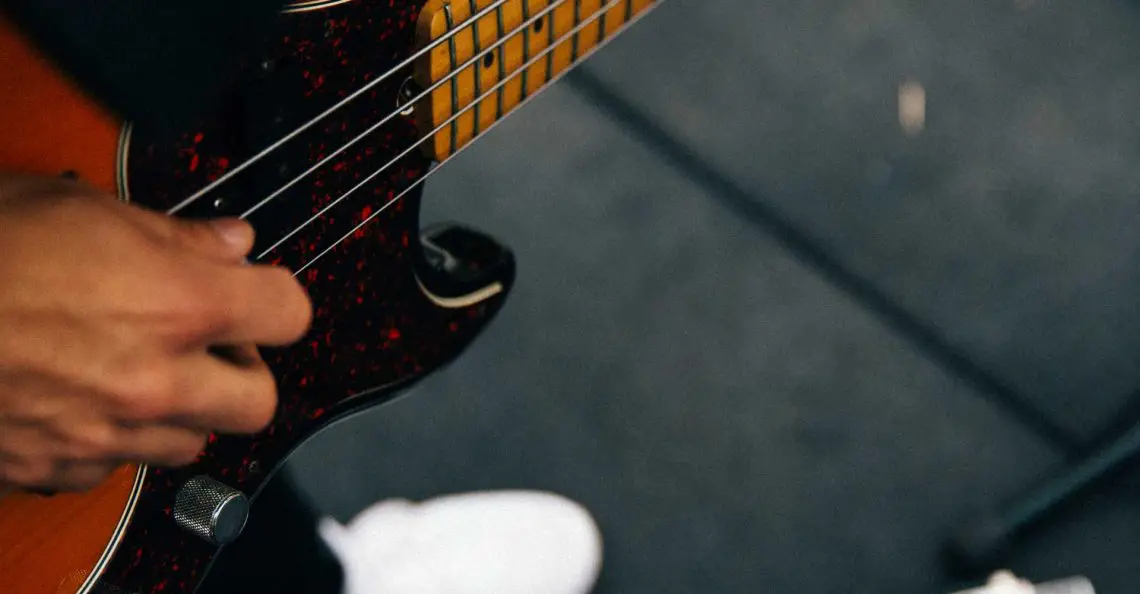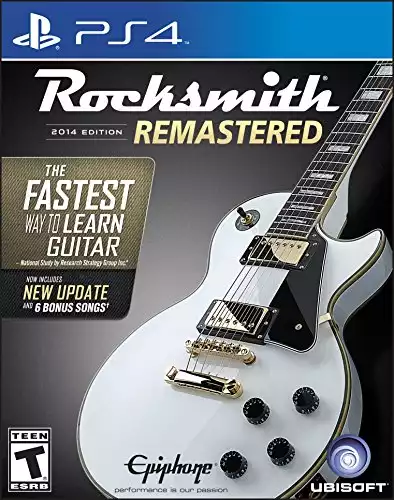Learning to play bass guitar as a beginner has never been easier. There are more than a few ways to learn the bass guitar with cross-platform apps like Yousician, Tuxguitar, and FouChords Guitar Karaoke, but the undisputed leader in this space is Rocksmith, which has been dominating the field and creating new bassists since 2011.
The original Rocksmith is starting to feel pretty old, and they’ve recently released Rocksmith+ as a new subscription service (unlike the original, which you’d buy once). With the subscription, however, it gives you access to a whole library of licensed music.
The most important thing to do is to have fun with it so you stay motivated and keep playing.
I play both bass and standard guitar, and I wouldn’t be where I am without having played Rocksmith for the past five years. This program plays like a game, and with daily practice, you can learn many of the more complicated aspects of playing just about any guitar. I even know of fellow Rocksmithers that have gone on to receive musical scholarships as a result of using the software, and since it’s so accessible and easy to learn, Rocksmith even has a 60-day challenge that has had many users, myself included, amazed at how much progress is possible with the software.
Since this original game, a sequel was released: Rocksmith 2014, which is the version that I’ll be talking about in this guide. This game is now available on several platforms, so it becomes straightforward to learn and gain confidence playing the four-strings of your favorite bass.
Rocksmith in a Nutshell
Rocksmith is specifically designed to teach casual and not-so-casual players the ins and outs of playing both bass and standard guitar, and there are a plethora of tools that you can use to get better using the software. For example, once you’ve mastered the songs that ships with Rocksmith, you can opt to use downloadable content, which is also called DLC. These DLC songs will provide you with thousands of hours of extra play, and it’s easy to spend a lot of cash on their in-game store just purchasing some of your favorite tracks for bass guitar.
The game color-codes each string so that the E, D, A, and G strings are colored red, yellow, blue, and orange. This feature makes it easy to learn how each string performs and how to differentiate notes. While most players will eventually learn tablature, this is an excellent place to start for new bassists, and it’s also a surprisingly versatile system for even advanced players to use.
Where Rocksmith Stands Out
There’s a saying that states that 10,000 hours are required to attain mastery in a discipline, and bass guitar players can benefit from extended hours learning the bass using this software, which is why I always check my Steam play hours before my practice sessions. Currently, I’m more than 1,300 hours into my Rocksmith experience, which provides a “progress bar” for my playing.
It’s important to know that the game doesn’t support five-string basses, so if that is your preferred bass guitar, this game may not be much help. That being said, just about every song selected for the base game and its downloadable catalog include bass tracks, so you’ll undoubtedly have a lot of variety if you own a four-string.
Some of the Features of Rocksmith that Can Help Bassists
A music educational game like Rocksmith needs to have multiple ways for a guitarist to learn without feeling like the whole process is tedious. In my experience, one of the best aspects of this game is how many options it gives you. It’s relatively easy to select “Learn a Song,” and use that as your primary learning tool for improving your bass playing, but if you take a few moments, you’ll realize that there are more than a few options available that will help you learn and retain new bass skills. These include:
Learn a Song
If you’re just looking to play through Rocksmith’s catalog of available music, which includes DLC, then “Learn a Song” is where you want to start. This groups your music in a variety of ways so that you can opt to sort it by band, tuning, or even alphabetically. In this part of the game, you can’t fail, but you’ll be evaluated by the percent of the notes that you hit correctly.
Guitarcade
As the name suggests, Guitarcade tries to provide an arcade-like experience for bassists looking to learn using Rocksmith. Not only are there more than a few classic arcade-style games to choose from, but I find it amazing how many of these games have extensive replay value. Here’s a list of some of the games that Rocksmith provides for bassists (It’s important to note that not every game that’s available for guitarists is present here for bass players):
Gone Wailin’ – If you’re looking to learn volume dynamics, then this is a game that can be very useful. Gone’ Wailin is designed to teach you to strum when you need sound and mute the notes when you don’t. The game itself features a protagonist that is propelled upwards via the blowhole of his pet whale. To reach new heights, you strum quickly and to lower the main character, you ease off or mute the strings.
String Skip Saloon – This technique game is another strummer, but this time, there’s no mute component; you must strum the appropriate colors of the string as the cowboys approach the bar in a straight line. Eventually, you’re bombarded with parched cowboys, so it takes quick speed and knowledge of the fretboard to succeed.
Ducks ReDux – Individual notes are essential in Ducks ReDux. The game is set up in an 8-bit format that might remind some of an Atari game. The base of the screen has numbers that correspond to frets, and from these frets, pixilated ducks travel from the bottom of the screen to the top. If they reach the top, it’s game over, so your job is to strum the appropriate fret to destroy the ducks and eventually change strings.
Ninja Slide n – If you’re looking to develop calluses, then sliding constantly in Ninja Slide n is a great way to do it. Your job in this technique game is to, you guessed it, slide. The main character here is a polygon ninja that slides from note to note. Overshooting the slide will slow you down, and you don’t want to fall behind because there’s a beam of electricity that always follows you as you progress.
Scale Warriors – If you’ve ever played the classic River City Ransom on the NES, then you’ll love this technique game. While you don’t crunch buttons, you are required to hit notes on scales such as:
- Pentatonic
- Ionian
- Blues
- Phrygian Dominant
- Lydian
- Aeolian
- Mixolydian
Hitting these notes on the scales defeats the enemies that show up, and there are even super-tough bosses to attack as you progress through the levels.
Hurtlin’ Hurdles – This game plays something like an extreme sport; you’re in control of a runner that has to jump to get over hurdles and grab power-ups. It’s extreme because there’s a giant roller spinning behind you and you have to relay to other runners from time to time, which happens when the game wants you to change strings. To run, you need to tremolo, which is when you strum the bass string quickly in a rhythmic fashion. This one will make strumming come more naturally and is an excellent way to build endurance.
Temple of the Bends – Bending is very important in guitar playing, so developing the finger muscles to bend the thick bass strings can be very useful. Enter Temple of the Bends, which is an old-school platformer that has your main character climbing up and down vines as the environment scrolls downwards. To make the vines bend up and down, you’ll need to bend the corresponding string up and down. This is a game that I credit for making bending easy.
Scale Racer – Like Scale Warriors, this game is designed to make all of the previously mentioned scales easier to understand, which will make your strumming and fretting much quicker. In this case, you’re a crook escaping the police by car, and hitting the notes on the scale will allow you to speed up and dodge obstacles on the road.
Harmonic Heist – Another fun, crime-themed game, harmonic heist helps you develop your harmonics skills. You play the role of a master cat burglar, and to sneak through the museum that you are robbing, you have to hit the correct harmonic notes so that you can make your way to the next target. Harmonics are difficult sometimes, but fortunately, there’s a whole area of the game that can make them more comfortable so that you can play this heist correctly.
In addition to the Technique Games, there is also a Score Attack section as well as a Leaderboard Challenges section in the Guitarcade. When it comes to Score Attack, this part of the game plays similarly to the “Learn a Song” aspect of the game. The primary difference is that you can fail out of a song if you mess up too much and hitting notes precisely will earn you points. There are four difficulty levels in Score Attack that include: Easy, Medium, Hard, and Master. As you might expect, each difficulty increases the note count, and if you make it to Master, then the notes disappear from the fretboard, and you’ll be expected to know them by heart.
Leaderboard Challenges isn’t really its own thing; it’s primarily a way to track specific achievement-like challenges that you carry out in the individual technique games. For example, one challenge may ask you to collect 100,000 points in Scale Warriors.
Nonstop Play
If you find that you typically have limited time, then you’ll want to consider nonstop play, and while that may seem counterintuitive, this play mode lets you establish a preset amount of time that you can play, and you can either opt to play random music or a specific set list that you select. As mentioned, this is an excellent tool for people that don’t have a lot of time to play; I frequently use it on my breaks because it keeps me honest by letting me play for ten or fifteen minutes at a time. If you find yourself with extra time, the mode has a “One More Song” feature that will randomly select another song for your to play after the preset time has expired.
Tone Designer
If you ask any guitarist how to vary up your sound a bit, most will tell you that you’ll need to construct a pedalboard. Guitar effects pedals are a great way to make your bass guitar sound completely different, but purchasing 30-plus pedals for a super-large pedal board can be a bit expensive. Fortunately, the tone designer in Rocksmith allows you to create some of these same effects digitally in the game. The tone designer will let you play with the tones that you create, and you’ll be able to assign them to the preamp, the amp, the cabinet, or even loop them a bit for a unique sound.
Once you’re ready, the game also shows you a pedal that you can adjust so that you can craft the sound that you want. All in all, if you’re at all interested in sound design for your bass guitar, then you can spend thousands of hours just tweaking the tones being output by your speaker as you play. This is also perfect for those that want to emulate their favorite basslines – you can select preloaded tones from your favorite songs and use them to recreate the sound of the bass legends.
Multiplayer
While it’s easy to think of Rocksmith as just a learning tool, it’s also important to understand that Ubisoft designed it also to be fun so that it’s less of a chore to learn bass and standard guitar. For this reason, gamification features like points, player performance levels, and achievements were all added to the game. Another features that many love about Rocksmith is its Multiplayer mode. With this mode, you can play with a friend who will be able to play bass, lead, or rhythm guitar simultaneously.
The chief drawback is that you can’t do this online due to the fact that the internet will add too much latency to the second player’s music, but if you have a second guitar and a friend in close proximity, this can be a very entertaining way to play Rocksmith and learn while you have fun.
The Kinds of Techniques Rocksmith Can Help You Master
Learning to play advanced bass isn’t easy; some techniques are clear separators between good bassists and amazing bassists, and amazingly, Rocksmith has the majority of these techniques on offer for just about any bassist that wants to learn. For example, the “Lessons” mode is loaded with video tutorials that help you learn some of the techniques that are integral to bass playing, and once the video lessons are done, you’re expected to try to play some relatively challenging bass guitar to show that you’ve mastered the technique.
If you are consistently failing, the software will recognize this and restart the section you’re having trouble with at a slower speed, which will allow you to understand better the note progression and the techniques associated with the lesson. This is very useful, and I’ve used it many times to iron out the kinks in my playing so that I can evolve as a musician.
Here are just a few of the advanced techniques that you can learn under the “Lessons” mode:
Slap Bass – If you’ve heard a blues song or even the theme from Seinfeld, then most likely, you’ve heard at least one instance of slap bass. Slap bass playing requires that you virtually slap the strings with your thumb knuckle. This lesson takes the time not only to show you how to not mute the string when you’re slapping it but also how to “pop” the string for a percussive effect. This is considered a “master class” lesson, but it’s beneficial for bassists that are trying to advance their playing skills.
Frethand Mutes – Like with standard guitars, you don’t have to cover the strings at the base of the bridge to keep the note from ringing out. If you master frethand mutes, you can achieve this muted sound effect by reducing the pressure on the strings. This lesson in Rocksmith takes you through several example videos before letting you attempt a complex, frethand mute-heavy song.
Roots and Fifths – When it comes to music playing, it’s essential to learn the common patterns so that you can be ready for just about any song. The roots and fifths lesson, which falls under Bass 201 (Rocksmith presents its lessons as if they are college courses), helps you identify the common themes in your basslines. Like other lessons, you end up with several complex basslines that will help you get started on learning roots, fifths, and octaves.
Fingering and Picking – It’s a common theme that many bassists feel that the only “true” way to play the bass is by fingering. While I think picking is a perfectly valid way to play the bass, Rocksmith’s lessons show both picking and fingering techniques so that you can have a solid basis for your bass playing.
Accents – Music is a living, breathing thing, and adding accents to your sound is just one way to express yourself as you play. Rocksmith’s lesson on accentuation is very straightforward, and it even gives you a practice track that will help you learn how to add accents to your sound.
Some of the Best Bass Songs on Rocksmith
Now that you understand some of the tools that are available to you when you play Rocksmith as a bassist, you probably want to get an idea of the music library that’s available in-game. Right out of the box, the game comes with 66 songs, and many of these songs are genuinely great bass-friendly tracks that you’ll love to play for years, but that being said, there are some that have mediocre basslines. Don’t sweat it, between these 66 songs and the DLC that’s available on every platform, the bass experience in Rocksmith is genuinely amazing.
In this part of the guide, I’m going to show you some great examples of bass guitar music that you can learn in the game:
1) Highway Star – Deep Purple
The standard guitar section with its mutes is already very percussive, but the basslines throughout this song blow this beat-heavy sound out of the water. This song is fast-paced that the game recommends that you pick rather than finger it, which your fingers will definitely appreciate. You’ll be strumming so fast with this song that you might feel like the whole song is one big extended tremolo, but there are enough pauses throughout to give your forearms a break. That being said, expect that your fingers will be all over the fretboard, but when you master it, you’ll have appreciated the effort because this is a track that cranks it up to 11. This is a song that’s available through DLC.
2) Big Bottom – Spinal Tap
Speaking of cranking it up to 11, no one does this better than fictional band Spinal Tap. One of the coolest aspects of this song is that it incorporates two different bass parts, and each of these bass sections sounds great. Rocksmith allows for this by having an “Alternate Bass” section for the song, so if you have a fellow bassist around, this is a great multiplayer bass song. You may even love the fact that there the main bass section has a very unique-sounding pedal effect, which makes the song pop. When I hear this song, it’s this bassline that pops out for me. This song is part of a DLC pack.
3) Jessica – The Allman Brothers
The Allman’s Jessica is one of the most famous rock ballads that came out of the 1970s, and many people know it for its beautiful-sounding guitar riffs, but the bass, in my opinion, shines just as brightly in this particular track. During the section of the song that has only two guitar strums, you’ll be amazed at the complex riffs that you’ll find on bass. The bass section of this song is incredibly detailed and addicting. Once you start learning this one, expect to spend a least a few months getting to know and master the song’s complexities. This song originates as DLC for the original 2011 Rocksmith.
4) My Generation – The Who
This song is a display of just how talented the late John Entwhistle was on the bass; it’s packed with his famous flourishes and is definitely a song to consider learning to play. There’s a lot of back and fort fretting, so you can practice for this one in one of the scale-based technique games that comes with Rocksmith. That being said, there are sections in this song that are just going to take you a while to master, especially in the section that begins around 2:30. Fortunately, this song comes packed in with the game, so you can start practicing right away.
5) Good Times – Chic
Bass is versatile, and if you’re a fan of disco-era funk, then Chic’s Good Times is a song with some truly epic bass. While it may seem a bit repetitive from a bass perspective, there’s still quite a bit of complexity throughout the song. The song has hammer-ons, open notes that suddenly lead to single notes, and a few tougher slides that seem to come out of nowhere. This is actually a legacy DLC from the original Rocksmith, but you can get it for Rocksmith 2014.
6) Refugee – Tom Petty and the Heartbreakers
Refugee is an entertaining song to play on bass because it has more than a few slides, a wide array of sustained notes, and more than a few hammer-ons to keep you engaged. The legend Ron Blair originally played the bassline, and this is just one of the songs that you’ll want to just amp-in and play from time to time, even without Rocksmith. Like some of the other tracks here, you’re going to have to put in a lot of practice, but in the end, it’ll definitely be worth it. This song is DLC for Rocksmith 2014.
7) Black Betty – Ram Jam
This is an iconic song that’s outright deceptive when you’re learning it on bass. The bassline has a straightforward starting point, but at the 1:45 mark, the song really cranks up the difficulty level so that you’ll be strumming and fretting like a madman/woman. After this section is done, you may want to breathe a sigh of relief, but soon after, at the 2:10 mark, it gets even harder! Still, Rocksmith has more than a few tools like its Riff Repeater to make the song a bit easier as you practice, so slow things down from time to time so that you can get it down. This song was part of the DLC for the original 2011 Rocksmith.
8) Brand New Kind of Blue – Gold Motel
This one is very deceptive as well because it has such a simple, bubblegum sound, but about a minute into the song, it starts to get very frantic, and even experienced bassists may begin to struggle. Fortunately, many of the other parts of the song are very pleasant to play, and you’ll love the quick slide notes that can be found throughout. This is a great finger-friendly song even when you play the faster parts, so give it a look. This is a song that is on-disc when you get Rocksmith 2014, so you can play it right out of the box.
9) We Share the Same Skies – The Cribs
This song, which comes from the Cribs, has a catchy sound and some very punchy guitars. The band is fronted by two twin brothers – one that plays lead and the other bass. The bass section of this song features a lot of open E notes, but that doesn’t mean that the song is simple to play. There’s a lot of quick, precise strumming that you’ll need to master this, but fortunately, it stays at a fairly even level of difficulty. This is another song that shipped with the original version of Rocksmith, so it’s just a transfer away for those looking to play it on the 2014 version of the game.
10) Love that’s Gone – La Sera
The final song in this guide is from La Sera, and it starts out simply enough with a series of repeating open A notes, but once the song gets into full swing, the bass shines as one of the better parts of the song. Still, this isn’t an overly tricky song to play on the bass, but it is a fun one to learn for beginners that want to build their skill. This comes packed-in with Rocksmith 2014.
Wrapping it Up
Learning to play bass is made much easier by a game like Rocksmith, and features like its expansive choice of songs, well-designed lesson structure, and the fun factor that Ubisoft baked into the game make it an excellent choice for new bassists. While no educational tool for musicians is perfect, Rocksmith is a great place to start – make sure you put in the time, and you’ll see some amazing progress.
Sources
- Smith, J. (2018, August 14). Personal Interview
- Stegner, B. (2016, August 25). Why Rocksmith 2014 is the Perfect Tool for Guitar Beginners. Retrieved from https://www.makeuseof.com/tag/rocksmith-perfect-tool-guitar-beginners/
- 25 More Rocksmith Basslines You May Have Missed Out On. Retrieved from https://theriffrepeater.com/25-more-rocksmith-basslines-you-may-have-missed-out-on/









Start the discussion at talk.hearthemusicplay.com